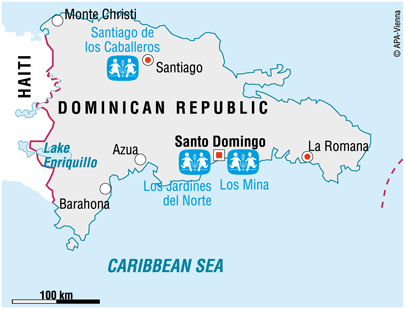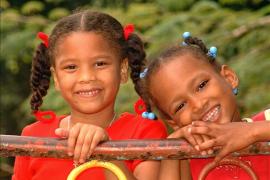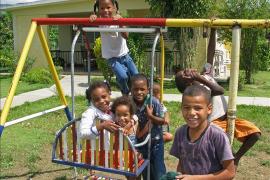
Vi er i Dominican Republic
Some facts about the Dominican Republic
The Dominican Republic forms part of the Antilles. It covers the oriental side of Hispaniola, the second largest island in the Caribbean after Cuba. Neighbouring Haiti occupies the other half of Hispaniola, making the island one of only two in the Caribbean that is shared by two states. In 1844, the Dominican Republic became an independent nation when a group of revolutionaries seized power from the Haitian rulers of Hispaniola. Remarkably, independence was won long before the abolishment of slavery in the region and the decolonization of other Caribbean islands.
The Dominican Republic is mainly inhabited by people of mixed European and African origins. Santo Domingo, the country's capital, is a melting pot of cultures. Many foreign visitors travel to the Dominican Republic for vacation. Tourism therefore accounts for an important share of the country's gross domestic product. The total population of the Dominican Republic is roughly 10 million.
The Dominican Republic is mainly inhabited by people of mixed European and African origins. Santo Domingo, the country's capital, is a melting pot of cultures.
Poverty, HIV, and Commercial Sexual Exploitation Remain Pressing Challenges
Like many other countries in the region, the Dominican Republic remains marked by persistent socio-economic inequality: there is a big divide between the rich and the poor. Among 177 countries, the Dominican Republic is ranked 88th by the Human Development Index (HDI).
Poverty remains a widespread phenomenon in the Dominican Republic. Approximately one fifth of all Dominicans live in shacks, the vast majority of them without access to running water, proper sanitation and electricity. Roughly 20 per cent of the Dominican Republic's population are struggling to make a living on less than two US dollars a day. In a country that is home to hundreds of luxury tourist resorts, one in five citizens is chronically undernourished.
While tourism has recently accounted for an important source of income, it has also been associated with substantial problems the country is facing, including the commercial sexual exploitation of women and children. Commercial sexual exploitation of children by foreign tourists and locals persists, particularly in coastal resort areas of the Dominican Republic. Poverty, gender inequality, history of domestic violence and sexual abuse, and lack of access to education are common push factors that increase a child's vulnerability of being sold into sexual slavery. The Dominican Republic is a source, transit, and destination country for persons subjected to sex trafficking.
Rising rates of forced prostitution and demand for commercial sex is a factor associated with increases in the prevalence of HIV infections in the Dominican Republic. As young girls and women are more likely to be prostituted by traffickers, they are also at greater risk of contracting HIV and other STIs. In comparison with most other countries in Central America and the Caribbean, the Dominican Republic is marked by a relatively high HIV/AIDS prevalence rate of 1.1 per cent. In certain urban areas, HIV infection rates are as high as 10 per cent.
Poverty remains a widespread phenomenon in the Dominican Republic. Approximately one fifth of all Dominicans live in shacks, the vast majority of them without access to running water, proper sanitation and electricity. Roughly 20 per cent of the Dominican Republic's population are struggling to make a living on less than two US dollars a day. In a country that is home to hundreds of luxury tourist resorts, one in five citizens is chronically undernourished.
While tourism has recently accounted for an important source of income, it has also been associated with substantial problems the country is facing, including the commercial sexual exploitation of women and children. Commercial sexual exploitation of children by foreign tourists and locals persists, particularly in coastal resort areas of the Dominican Republic. Poverty, gender inequality, history of domestic violence and sexual abuse, and lack of access to education are common push factors that increase a child's vulnerability of being sold into sexual slavery. The Dominican Republic is a source, transit, and destination country for persons subjected to sex trafficking.
Rising rates of forced prostitution and demand for commercial sex is a factor associated with increases in the prevalence of HIV infections in the Dominican Republic. As young girls and women are more likely to be prostituted by traffickers, they are also at greater risk of contracting HIV and other STIs. In comparison with most other countries in Central America and the Caribbean, the Dominican Republic is marked by a relatively high HIV/AIDS prevalence rate of 1.1 per cent. In certain urban areas, HIV infection rates are as high as 10 per cent.
Situation of the children in the Dominican Republic
The combination of widespread, structural poverty and a comparatively high HIV rate particularly affect the country's most vulnerable segment of population: Dominican children. More than one million children in the Dominican Republic live in poverty and roughly 578,000 children under the age of 15 are without parental care. Around 20 per cent of them are orphans.
Among the most relevant factors that increase the likelihood of a child losing parental care are: child pregnancy, chronic diseases such as HIV, mental or physical disabilities and prison sentences of the child's parents. Children whose parents have contracted the HIV virus suffer the effects of economic hardship. Additionally, their families are often being discriminated against and stigmatised. A high number of children become orphans because their parents die from AIDS. Many of these children end up in the streets where they face a life under precarious circumstances. In order to survive, they are forced to work and give up school.
The Dominican Republic Child Labour Survey indicates that roughly 15 per cent of all Dominican children aged 5-14 are engaged in labour activities. As soon as they stop going to school, their lives are often marked by a vicious circle of drugs, crime and violence. Approximately 17,000 children who participate in the labour force do so without attending school. The percentage is particularly high for boys and for children who live in rural areas.
Among the most relevant factors that increase the likelihood of a child losing parental care are: child pregnancy, chronic diseases such as HIV, mental or physical disabilities and prison sentences of the child's parents.
The Dominican Republic Child Labour Survey indicates that roughly 15 per cent of all Dominican children aged 5-14 are engaged in labour activities. As soon as they stop going to school, their lives are often marked by a vicious circle of drugs, crime and violence. Approximately 17,000 children who participate in the labour force do so without attending school. The percentage is particularly high for boys and for children who live in rural areas.
SOS Children's Villages in the Dominican Republic
SOS Children's Villages currently works in three locations in the Dominican Republic where our organisation is supporting local young people and children by providing day-care, education and medical services.
Additionally, the organisation started to operate family strengthening programmes in the Dominican Republic. These programmes enable children who are at risk of losing parental care to grow within a caring family environment. Children whose parents cannot take care of them will find a loving home in one of the SOS families.
Website of SOS Children's Villages Dominican Republic
(available in Spanish)

